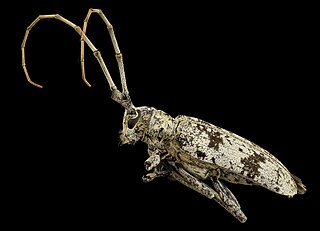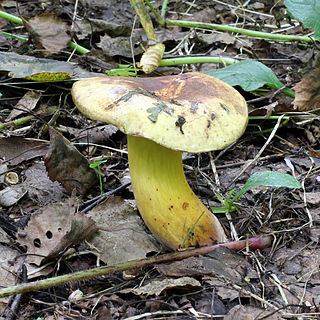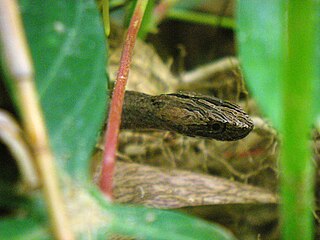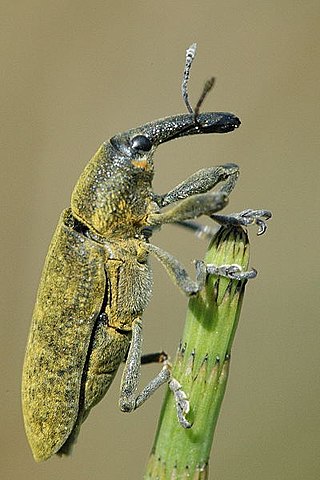
Psammodynastes pulverulentus, the common mock viper, is a species of snake native to Asia.

The Cape grey mongoose, also called the small grey mongoose, is a small mammal native to South Africa, Lesotho and southern Namibia.

Albuginaceae is a family of oomycetes.

Goes is a genus of longhorn beetles, containing the following species:

The smoky flying squirrel is a species of rodent in the family Sciuridae. It is monotypic within the genus Pteromyscus. It is found in parts of Brunei, Indonesia, Peninsular Malaysia, and southern Thailand, but its range may be more extensive than currently mapped. Their natural habitat is subtropical or tropical dry forests. It is listed as an endangered species because of estimated population loss of 50% in past and future, judging from extensive and rapid habitat loss.

Cyanoboletus pulverulentus, commonly known as the ink stain bolete, is an edible bolete mushroom. It is found in deciduous and mixed forests, particularly on moist soil on slopes and under beech and oak trees. A common species, it is found in northern Asia, Europe, North Africa, Central and northern South America, and eastern North America. All parts of the mushroom will stain dark bluish-black after handling. A recent study has revealed this mushroom hyperaccumulates arsenic and therefore it's consumption should be limited.

Gonipterus gibberus is a species of weevil in the family Curculionidae. It is commonly known as the eucalyptus snout beetle, the eucalyptus weevil or the gum tree weevil. It feeds and breeds on Eucalyptus trees and is endemic to Australia.

Gonipterus is a genus of weevils in the family Curculionidae. There are approximately 20 described species in the genus, most of which are native to Australia. They are all plant feeders and many are specific to a single host species. Gonipterus platensis, Gonipterus pulverulentus, and an undescribed species infest a number of species of Eucalyptus and have spread to other parts of the world where these trees have been planted.

Prodoxus is a genus of moths of the family Prodoxidae. The members of this genus are known as bogus yucca moths.
Porcellio pulverulentus is a species of woodlouse in the genus Porcellio belonging to the family Porcellionidae that is endemic to mainland Spain.
Deserticossus pulverulentus is a species of moth of the family Cossidae. It is found in Kazakhstan, Kyrgyzstan, Uzbekistan, Turkmenistan, north-western China (Xinjiang) and Israel.
Carpostalagma pulverulentus is a moth of the subfamily Arctiinae. It was described by George Talbot in 1929. It is found in Kenya and Uganda.
The purple swamphen has been split into the following species:
Paul Konrad was a Swiss geometrician and amateur mycologist.

Psammodynastes is a genus of elapoid snakes, containing two species native to tropical and subtropical Asia. It is the only member of the family Psammodynastidae. They are also known as mock vipers due to their superficial resemblance to true vipers. Their Batesian mimicry of vipers extends to them having a fake venom fang at the front of the mouth revealed during threat displays, although they are actually rear-fanged snakes with weak venom meant for small animals.
Zographus pulverulentus is a species of beetle in the family Cerambycidae. It was described by Nonfried in 1906, originally as a varietas of Zographus aulicus. It is known from the Democratic Republic of the Congo and South Africa.
Odontocorynus pulverulentus is a species of flower weevil in the beetle family Curculionidae. It is found in North America.

Agnocoris pulverulentus is a species of plant bug in the family Miridae. It is found in North America.

Lixus pulverulentus is a species of weevil belonging to the family Curculionidae. The species was scientifically described in 1763 by Giovanni Antonio Scopoli as Curculio pulverulentus Scopoli, 1763.
Tetramelas pulverulentus is a species of lichenicolous (lichen-dwelling) fungus in the family Caliciaceae. It was originally described as a new species by Martino Anzi in 1860. The type specimen was collected in Italy. Swedish lichenologists Anders Nordin and Leif Tibell transferred it to the genus Tetramelas in 2005 based on molecular phylogenetic analysis. It is closely related to Tetramelas phaeophysciae but differs from that species in its ascospores, which have three septa.












